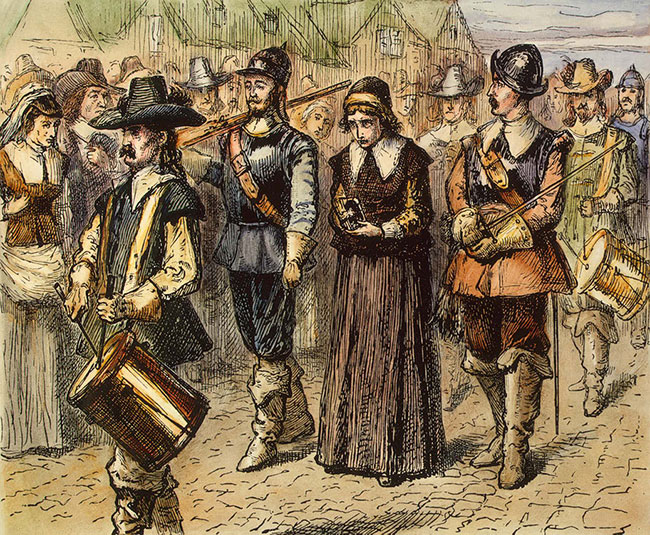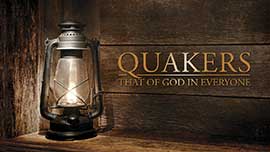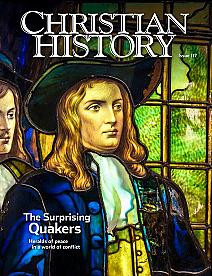MARY DYER FACED DOWN LAWS THAT BANNED RELIGIOUS FREEDOM

[Above: Unknown 19th century artist, Mary Dyer led to the gallows. Wikimedia. Public Domain.]
IRONICALLY, in light of Mary Dyer’s end, she came to America seeking religious freedom. A contemporary described her as
a person of no mean extract or parentage, of an estate pretty plentiful, of a comely stature and countenance, of a piercing knowledge in many things, of a wonderful sweet and pleasant discourse.
With husband William, she settled in the Massachusetts Bay Colony in 1635. Immediately the pair became involved in church life. Soon Mary took sides in the big religious controversy of Boston, the so-called “antinomian” (against-the-law) movement led by Anne Hutchinson. Hutchinson advocated Spirit-filled living (and a freer church) as opposed to a lifeless works-based system. When colony leaders excommunicated Hutchinson, Dyer rose and walked out with her. Meanwhile Dyer miscarried a deformed and stillborn child. Boston leaders exhumed the corpse, examined it and declared that its defects indicated Dyer’s spiritual deformity. Their descriptions suggest anencephaly (water on the brain) and spina bifida (improperly formed spinal column).
In 1638, the Dyers moved to Rhode Island where religious freedom was not only permitted but prized. William Dyer became a leader in the new colony. In 1650, Mary sailed to England leaving behind William and their six children. She became interested in the Seekers, disaffected English Christians who were seeking truth outside formal churches. William joined her in England either later that year or in 1651. When he returned to Rhode Island in 1653, Mary remained in England. Her association with the Seekers led her to Quaker founder George Fox. She became a Quaker around 1654 and did not return to America until 1657.
Unaware that Boston had outlawed Quakers, she landed there. For ten weeks she languished in jail, not permitted to communicate with anyone. She smuggled a letter to William who arranged her release, calling her conditions worse “than hogs and dogs.” Soon afterward, New Haven expelled Mary; she had gone to Connecticut to spread the new doctrines there. She wasn’t done with Boston either. Like other Quakers, she felt obliged to “look the bloody law in the face.”
To visit Boston took courage. Puritans added penalty to penalty against Quakers. Among the cruelties heaped upon them were starvation, exposure in the stocks and the pillory, whipping, fines, imprisonment, branding, mutilation (which could include having the tongue bored with red-hot instruments and ears cropped), seizure of property, banishment, or death. Persecutors paraded Quaker women in public stripped to the waist, flogging their naked backs and chests.
In 1658, Dyer was jailed when she came to the support of friends. The following year she was arrested a third time in Boston and sentenced to death. At the last minute, after making her watch the hangings of two Quakers, authorities gave her a pre-planned reprieve. They ordered her to leave Massachusetts, never to return. She then spent a few months with friends on Shelter Island (near Long Island) where she preached to colonists and Indians.
Afterward, Mary Dyer returned to Boston. Arrested a fourth time, she was sentenced to death. Given a final chance to renounce her faith, she refused. “Nay, I cannot; for in obedience to the will of the Lord God I came, and in his will I abide faithful to the death.” On this day, 1 June 1660, Boston leaders hanged Dyer. Loud drumming prevented the crowd from hearing her final words, but a bystander reported she said, “Yea, I have been in Paradise these several days and now I am about to enter eternal happiness.” Friends in Portsmouth, Rhode Island, recorded the event (although they got the date wrong): “She was put to death at the Town of Boston with ye like cruil [cruel] hand as the martyrs were in Queen Mary’s time.”
Her death is often credited with ending executions of Quakers in Massachusetts. Edward Burroughs described to King Charles the colonial mistreatment of Quakers, likely mentioning her case, and Charles forbade Massachusetts from executing any more of the sect. He commanded they be sent to England for disposition. However, Massachusetts authorities continued to whip Quakers until 1665.
—Dan Graves
----- ----- -----
For more on Quakers watch the video Quakers: That of God in Everyone at RedeemTV.
(Quakers can be purchased at Vision Video)








